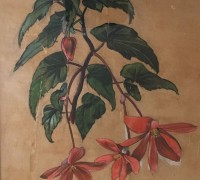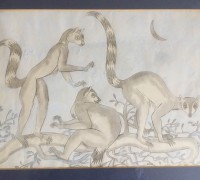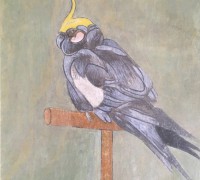Art School
Silvia clearly had a talent for art and design. At school she excelled at art and won a Scholarship for £50. She remembers her Grandmother being good at painting with watercolours. There is, however, no record of either Grandmother being an artist; she may be referring to her Aunt Anna (Baker) who was an amateur artist and exhibited watercolours in Dublin.
According to her journal, when she was 15, she tried to teach herself to draw by reading Ruskin’s Elements of Drawing. However, he goes on preaching so much about Nature that Silvia was under the impression that Nature was a task-mistress… and it was (only) many years later that I found one could be in love with her. For reasons unknown, when she left school, instead of going to art school she enrolled at the Academy of Dramatic Art (later RADA) – see Actress
Subsequently, Silvia attended the Slade School of Art, probably from around September 1916 to 1919. Towards the end of the war, the formidable Professor Tonks returned from active service and became one of her tutors. At her first lesson with him, he impressed upon her the need for proportion and direction of lines. Later she came to recognise that you need to know ‘the thing’ that you are drawing as well as how to draw.
Silvia would have been older than the majority of students and most of her friends and contacts were also older, several having been at the Slade (the likes of Gilbert Spencer, Dora Carrington, Paul Nash) when she was busy studying drama. Evidently, she earned some money to pay her way through college by teaching elocution, one day a week, at a finishing school in Esher.
Post Art School
Silvia drew animals at London Zoo, almost every day, for fifteen years. Her endeavours resulted in the publication of a book and newspaper articles – see Author. She compares the patience required for drawing wildlife as being like fishing for you can work all day long and never find an animal that will pose properly for you and then you go home with a portfolio that is blank, except possibly for an ear, an eye and a waving tail. If she needed flowery backgrounds for her drawings of birds or monkeys, she would go to Kew Gardens and sketch camellias or orchids.
My mother wrote that she (and her younger brother) “loved Aunt Silvia as she was so different. She was an artist and had a studio and asked us to do lovely things like helping her clear her paints or go with her to the zoo where she drew all the animals. We used to go with her behind the cages with the keepers and were often allowed to touch or hold animals.”
Most of Silvia’s paintings were of animals, birds and flowers but on her travels she concentrated on portraits, often of children. Although interested in buildings and religions, they do not feature in her artwork. Nor are there examples of work that might have been influenced by the innovative movements between the wars – dadism, surrealism, abstract art. At heart, she was a traditionalist – even if some of her behaviour was unconventional by the standards of the day. Her classical training informed her output as well as her draughtsmanship (which was much admired by Ralph Hodgson). She wrote in 1948 that she was devoted to Ingres and found it difficult to appreciate Impressionists. Ten years later, she worried that she had never found the style that expresses what I want in paintings.
In 1960, Silvia had the opportunity to exhibit in Paris and, whilst there, enjoyed visiting the Louvre – notably the Early Renaissance rooms. Her rent, however, increased again and, in order to save money, she resorts to framing her own drawings but struggles with the cardboard mounts. In 1963, she was pleased to have one of her paintings accepted for a Royal Academy Exhibition but it seems her memory was beginning to deteriorate by this stage.
After WW2, she belonged to the Society of Women Artists and the Society of Graphic Art, as well as a Sketch Club affiliated to the RBA. As she grew older, however, her antagonism towards abstract art increased. She wrote I can’t help detesting modern art (1962) and complained that dealers and critics only take notice of abstract artists.
A sizeable number of her animal and bird sketches are in the family collection, along with some flower paintings and a few portraits. Occasionally, her artworks now surface at auctions around the world.
Silvia’s Studio (probably) in Vicarage Gate – Family Collection
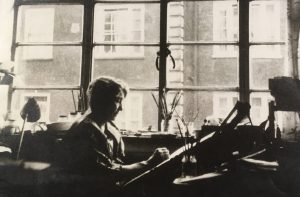
Exhibitions (known to date…)
| 1929 & 1930 | National English Art Club |
| 1930 | Royal Society of British Artists |
| 1930 | Zwemmer Gallery (December) |
| 1931-1932 | Warren Gallery (Private View 1st Dec) |
| 1933 | Hardy’s Galleries, Leeds (15th-27th May) |
| 1951 | Redfern Gallery |
| 1959-63 & 1950 | Society of Women Artists |
| 1960 | Galérie de Bourgogne, Paris |
| 1963 | Royal Academy |
Also, a drawing of a Young Reed Buck (1928) was donated to British Museum in 1932, by the Art Collections Fund (via Sir Robert Witts).
Redfern Gallery: 3rd-28th April, 1951
Redfern Gallery holds a catalogue for this group exhibition. Besides Silvia, the other artists were: Adrian Ryan | Rowland Suddaby | Matthew Smith | Hippolyte Petitjean | Jaques Chapiro
Silvia exhibited 30 paintings. In the table below, most of those with a place name feature in one or other of Silvia’s travel books. The Gallery documents show that they sold at least 8 paintings. According to later correspondence (24.6.52), Silvia writes that 16 of them were sold.
| Painting | Place | Method | Guineas |
|---|---|---|---|
| Fisherman | Bali | drawing | 14 |
| Boy playing the Gamelan | Bali | egg tempera | 16 |
| Man with fighting-cock | Bali | watercolour | 18 |
| Fisherman | Bali | egg tempera | 25 |
| Market woman | Bali | egg tempera | 18 |
| Gardener | Bombay | egg tempera | 15 |
| Woman seated on ground | Bombay | egg tempera | 18 |
| Old woman | Cyprus | egg tempera | 25 |
| Carob-tree | Cyprus | watercolour on silk | 16 |
| Boy with donkey | Jamaica | watercolour on silk | 16 |
| Old woman | Poona | watercolour | 16 |
| Mario | Portofino | watercolour on silk | 12 |
| Maria Carmen | Spain | watercolour | 10 |
| Mother and Child | Spain | watercolour | 8 |
| Isabel and Isabelita | Spain | watercolour | 12 |
| Mother and Child | Spain | watercolour | 12 |
| Tarzan asleep | Tahiti | drawing | 8 |
| Head of Boy | oil | 16 | |
| Pigeon | watercolour | 7 | |
| Antelope | watercolour on silk | 9 | |
| Lilies and Carnations | oil | 25 | |
| Rhododendrons | oil | 20 | |
| Cockatoo | watercolour | 8 | |
| Harnessed Antelope | watercolour | 8 | |
| Antelope | watercolour | 9 | |
| Antelope | drawing | 6 | |
| Bird of Paradise and magnolia | watercolour on silk | 25 | |
| Parrot | watercolour | 8 | |
| Cactus | watercolour on silk | 9 | |
| Musicians in Bali | egg tempera | 25 |
Society of Women Artists Annual Exhibition at Royal Institute Galleries
| 1950 | Watercolours | incl Balinese Dancer (The Stage 15.06.50 p11) |
| 1959 | Watercolour | Beggar Woman, Spain |
| 1959 | Tempura | Old Woman, India |
| 1961 | Pencil | Child’s Head, Tenerife |
| 1961 | Pastel | Sabeh, Bali |
| 1961 | Tempura | Sabeh, Bali |
| 1962 | Pastel | Head of a Child |
| 1962 | Pencil | Genet |
| 1962 | Watercolour | Lacemaker |
| 1963 | pencil | Hornbill |
| 1963 | Tempura | Child’s Head, Tenerife |
| 1963 | ? | Head of a Woman, Spain |
Galérie de Bourgogne, Paris - 2 weeks in June 1960
Madame Lefèvre ran this Gallery and, in response to an advert which Silvia had seen in an art magazine, she was invited to hold an exhibition of her animal drawings. She spent a few days helping to hang the pictures prior to the Private View.
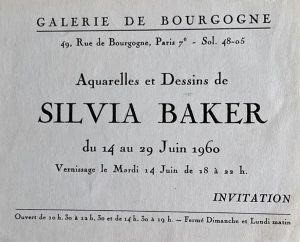
This was attended by the wife of the British Ambassador, Lady Gladwyn; also, by a nephew of Berlioz and some art critics, one of whom wrote a complimentary review. She was praised for her work which encouraged her confidence and meant she no longer felt that she was an old woman in a back-water practising a forgotten form of art, as she did in London.
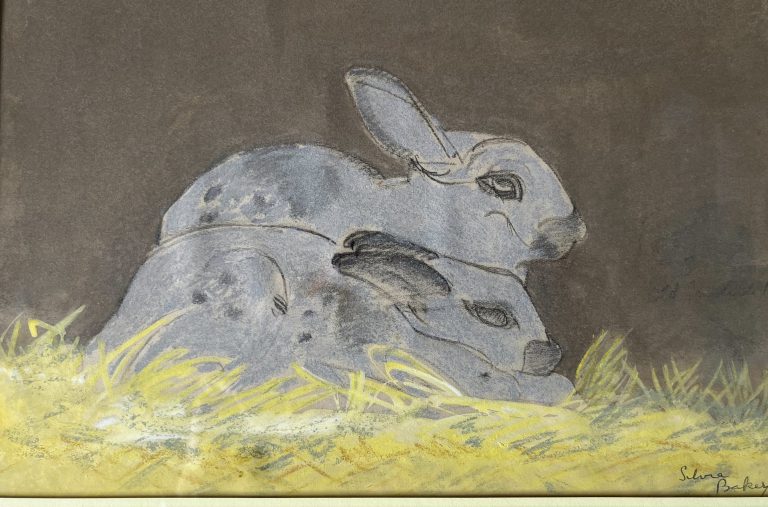
Royal Academy
1963 An Indian Woman from Poona (sold to an American, from New York, who bartered down the price by £5 – much to Silvia’s annoyance!)

